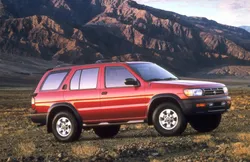

Nissan Pathfinder Generation 1 Overview
Discover the Nissan Pathfinder, focusing on Generation 1. Explore its features, specs, and why this model remains popular in Portugal.
The Nissan Pathfinder has been a staple of the SUV market since its introduction in 1985. The first generation of the Pathfinder, produced from 1985 to 1995, set the bar for what consumers could expect from a comp...
Technical Specifications
Select Version
Dimensions
Engine
Driving
Others
History and Features
Mycarro AI
Apr 27, 2025
The Nissan Pathfinder has been a staple of the SUV market since its introduction in 1985. The first generation of the Pathfinder, produced from 1985 to 1995, set the bar for what consumers could expect from a compact SUV. This vehicle combined the ruggedness of a truck with the versatility and comfort of a family vehicle, a formula that resonated with the growing segment of off-road enthusiasts and families alike.
Initial Release and Design
The Nissan Pathfinder was initially launched in the United States as a 1986 model, building on the platform of the Nissan Hardbody Truck. With its distinctive boxy design and primarily utilitarian aesthetics, the Pathfinder was designed to appeal to those seeking adventure without sacrificing everyday usability. The first generation Pathfinder measured approximately 175 inches in length, 65 inches in width, and stood around 66 inches tall, giving it a compact yet substantial presence.
Available in both two-wheel drive (2WD) and four-wheel drive (4WD) configurations, the first-generation Pathfinder catered to a diverse audience. The rugged construction derived from its truck lineage made it suitable for off-road environments while maintaining on-road drivability. This versatility was a crucial selling feature as it allowed families to comfortably commute during the week while venturing off the beaten path on weekends.
Engine and Performance
When it comes to performance, the Generation 1 Pathfinder was equipped with a 2.4-liter inline-four engine or a more robust 3.0-liter V6 engine, depending on the trim level. The four-cylinder engine produced around 143 horsepower, whereas the V6 upped that to approximately 160 horsepower, offering adequate power for both on-road and off-road driving. The option of a five-speed manual or a four-speed automatic transmission provided flexibility in driving preferences.
The 4WD model featured a part-time four-wheel drive system that allowed drivers to engage the system when necessary, enhancing traction and control across various terrains. This capability made the Pathfinder not only a dependable vehicle for family outings but also a capable companion for off-road adventures.
Interior Features and Comfort
Inside, the Generation 1 Pathfinder offered a practical layout designed for comfort and functionality. With seating for five passengers and a rear hatch that provided access to a spacious cargo area, the Pathfinder was ideal for family trips. Early models were equipped with basic amenities, such as a cassette player and air conditioning, which were considered premium features at the time.
In later years of this generation, Nissan enhanced the interior with improved upholstery, upgraded sound systems, and optional features like sunroofs and leather seating. These upgrades aligned with the growing consumer expectation for comfort and technology in vehicles, which only increased the appeal of the Pathfinder.
Safety Features
In terms of safety, the first-generation Nissan Pathfinder was equipped with standard features of the time, including seat belts and basic crash safety designs. However, the lack of more advanced safety technology, like airbags or anti-lock brakes, was a common drawback. As consumer standards evolved, so did the expectations surrounding vehicle safety, which pushed manufacturers like Nissan to innovate in subsequent generations.
Legacy and Cultural Impact
The first-generation Nissan Pathfinder left an indelible mark on the automotive landscape and remains a beloved model among enthusiasts. With its solid build, reliability, and off-road capabilities, it laid the groundwork for future Pathfinders and established Nissan as a serious contender in the SUV market.
As SUVs continued to grow in popularity throughout the 1990s, the Pathfinder became emblematic of a cultural shift where more drivers sought vehicles that could seamlessly transition from city streets to nature trails. The first-generation model's combination of ruggedness and comfort helped cement the SUV's place in American garages, shaping the industry for decades to come.
Conclusion
In conclusion, the Nissan Pathfinder Generation 1 stands as a testament to the evolution of the SUV market. With its unique blend of performance, comfort, and off-road capability, it fulfilled the demands of a diverse audience and set a strong foundation for its successors. As it continued to evolve, it remained rooted in the qualities that made it a favorite among drivers—a true pioneer in the world of sport utility vehicles.
